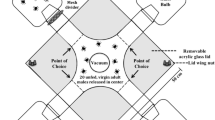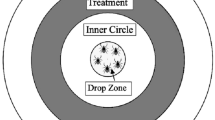Abstract
Three low molecular weight compounds were found in hexane: diethyl ether extracts of fed males of the African ticks,Amblyomma variegatum (tropical bont tick) andA. hebraeum (bont tick), namely,o-nitrophenol, methyl salicylate and 2,6-dichlorophenol. These same compounds were also found in a rinse of fedA. variegatum males, but were absent or present in only trace amounts in a rinse of fedA. hebraeum males.o-Nitrophenol and methyl salicylate were present in much higher concentrations (i.e., amounts/tick) inA. variegatum than inA. hebraeum. 2,6-Dichlorophenol was also more abundant inA. variegatum than inA. hebraeum, but the differences were not as great as with the former two compounds. Extraction in hexane over a 3-week period revealed four additional compounds, benzaldehyde, benzyl alcohol, benzothiazole and nonanoic acid. The first three compounds were found in males of both species; nonanoic acid was found only inA. hebraeum males. Published reports consistently show strong attraction byo-nitrophenol and methyl salicylate for both sexes of the two bont tick species; 2,6-dichlorophenol and benzaldehyde have been reported to be attractive to both sexes ofA. hebraeum. The possible roles of these compounds, as well as others occasionally reported fromA. hebraeum andA. variegatum, as components of the aggregation/attachment pheromone or other pheromones is discussed.
Similar content being viewed by others
References
Apps, P.J., Viljoen, H.W. and Pretorius, V., 1988. Aggregation pheromones of the bont tick,Amblyomma hebraeum: identification of candidates for bioassay. Onderstepoort J. Vet. Res., 55: 135–137.
Diehl, P.A., Guerin, P., Vlimant, M. and Steullet, P., 1991. Biosynthesis, production site and emission rates of the aggregation-attachment pheromone in males of twoAmblyomma ticks. J. Chem. Ecol., 17: 883–847.
Gladney, W.J., Grabbe, R.R., Ernst, S.E. and Oehler, D.D., 1974. The Gulf Coast tick: evidence of a pheromone produced by males. J. Med. Entomol., 11: 303–306.
Jaffe, H., Sonenshine, D.E., Hayes, D.K., Dees, W.H., Beveridge, M. and Thompson, M.J., 1986. Controlled-release reservoir systems for the delivery of insect steroid analogues against ticks (Acari: Ixodidae). J. Med. Entomol., 23: 685–691.
Kellum, D. and Berger, R.S., 1977. Relationship of the occurrence and function of 2,6-dichlorophenol in two species ofAmblyomma (Acari: Ixodidae). J. Med. Entomol., 13: 701–705.
Norval, R.A.I., Andrew, H.R. and Yunker, C.E., 1989a. Pheromone-mediation of host-selection in bont ticks (Amblyomma hebraeum Koch). Science, 243: 364–365.
Norval, R.A.I., Butler, J.F. and Yunker, C.E., 1989b. Use of carbon dioxide and natural or synthetic aggregation-attachment pheromone of the bont tick,Amblyomma hebraeum, to attract and trap unfed adults in the field. Exp. Appl. Acarol., 7: 171–180.
Norval, R.A.I., Peter, T., Yunker, C.E., Sonenshine, D.E. and Burridge, M.J., 1991a. Responses of the ticksAmblyomma hebraeum andA. variegatum to known or potential components of the aggregation-attachment pheromone. I. Long-range attraction. Exp. Appl. Acarol., 13: 11–18.
Norval, R.A.I., Peter, T., Yunker, C.E., Sonenshine, D.E. and Burridge, M.J., 1991b. Responses of the ticksAmblyomma hebraeum andA. variegatum to known or potential components of the aggregation-attachment pheromone. II. Attachment stimulation. Exp. Appl. Acarol., 13: 19–26.
Obenchain, F.D., 1984. Behavioral alterations between the sexes and aspects of species specific pheromone mediated aggregation and attachment inAmblyomma In: D.A. Griffiths and C.E. Bowman (Editors), Acarology VI, Vol. 1. Ellis Horwood, Chichester, pp. 387–392.
Rechav, Y., Parolis, H., Whitehead, G.B. and Knight, M.M., 1977. Evidence for an assembly pheromone (s) produced by males of the bont tickAmblyomma hebraeum (Acarina: Ixodidae). J. Med. Entomol., 14: 71–78.
Rechav, Y., 1978. Specificity in assembly pheromones of the tickAmblyomma hebraeum (Acarina: Ixodidae). J. Med. Entomol., 15: 81–83.
Schoni, R., Hess, E., Blum, W. and Ramstein, K., 1984. The aggregation-attachment pheromone of the tropical bont tickAmblyomma variegatum Fabricius (Acari: Ixodidae). J. Insect Physiol., 30: 613–618.
Silverstein, R.M., West, J.R., Khalil, G.M. and Sonenshine, D.E., 1983. Occurrence of 2,6-dichlorophenol in the hard ticksHyalomma dromedarii andHyalomma anatolicum excavatum and its role in mating regulation in these species. J. Chem. Ecol., 9: 1543–1549.
Sonenshine, D.E., 1985. Pheromones and other semiochemicals of the Acari. Annu. Rev. Entomol., 30: 1–28.
Sonenshine, D.E., Rechav, Y. and Silverstein, R.M., 1982. In: F.D. Obenchain and R. Galun (Editors), Physiology of Ticks. Pergamon Press, Oxford, pp. 439–468.
Sonenshine, D.E., Silverstein, R.M. and West, J.R., 1984. Occurrence of the sex attractant pheromone, 2,6-dichlorophenol, in relation to age and feeding in the American dog tick,Dermacentor variabilis (Say) (Acari: Ixodidae). J. Chem. Ecol., 10: 95–100.
Tamaki, Y., 1985. Sex pheromones. In: G.A. Kerkut and L.I. Gilbert (Editors), Comprehensive Insect Physiology, Biochemistry and Pharmacology, Vol. 9 (Behavior). Pergamon Press, Oxford, pp. 145–191.
Wood, W.F., Leahy, Sister M.G., Galun, R., Prestwich, G.D., Meinwald, J., Purnell, R.E. and Payne, R.C., 1975. Phenols as pheromones of ixodid ticks: a general phenomenon? J. Chem. Ecol., 1: 501–509.
Yunker, C.E., Andrew, H.R., Norval, R.A.I. and Keirans, J.E., 1991. Interspecific attraction to male-produced pheromones of two species ofAmblyomma ticks (Acari: Ixodidae). J. Insect Behav., 3: 557–567.
Yunker, C.E., Peter, T., Norval, R.A.I., Sonenshine, D.E., Burridge, M.J. and Buttler, J.F., 1992. Olfactory responses ofAmblyomma hebraeum andA. variegatum adults to attractant chemicals in laboratory tests. Exp. Appl. Acarol. (in press).
Author information
Authors and Affiliations
Additional information
Supported by Cooperative Agreement No. AFR-0435A-00-9084-00 with the U.S. Agency for International Development to the Department of Infectious Diseases, College of Veterinary Medicine, University of Florida, Gainesville, FL.
Rights and permissions
About this article
Cite this article
Lusby, W.R., Sonenshine, D.E., Yunker, C.E. et al. Comparison of known and suspected pheromonal constituents in males of the African ticks,Amblyomma hebraeum Koch andAmblyomma variegatum (Fabricius). Exp Appl Acarol 13, 143–152 (1991). https://doi.org/10.1007/BF01193665
Accepted:
Issue Date:
DOI: https://doi.org/10.1007/BF01193665




